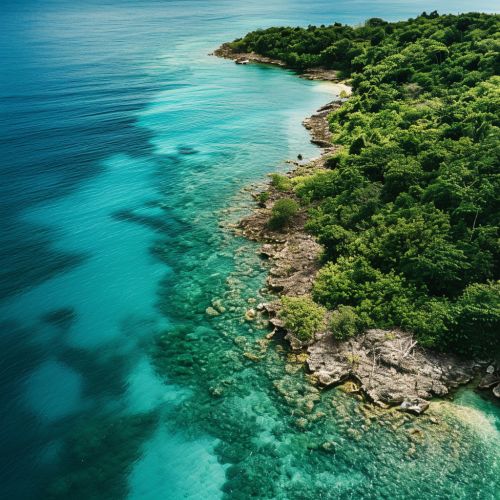Caribbean Region
Geography
The Caribbean region is a large area located in the southeast of the Gulf of Mexico and the North American mainland, to the north of South America, and east of Central America. This region is known for its tropical climate, beautiful beaches, and diverse cultures. It is made up of more than 7,000 islands, islets, reefs, and cays. The region is divided into the Greater Antilles, the Lesser Antilles, and the Bahamas archipelago.

Geology
The Caribbean region is known for its complex geological structure. It is home to both active and extinct volcanoes, and the region's geography is largely shaped by tectonic activity. The Caribbean Plate, a large tectonic plate underlying Central America and the Caribbean Sea, plays a significant role in the region's geology. The plate's movement has led to the formation of the Antillean volcanic island arc, which includes the Greater and Lesser Antilles.
Climate
The Caribbean region has a tropical climate, characterized by high temperatures and significant rainfall throughout the year. The region's climate is influenced by the Atlantic and Caribbean Sea, which moderate temperatures and help to maintain the region's high humidity levels. The Caribbean is also located within the Atlantic hurricane belt, making it susceptible to hurricanes and tropical storms during the hurricane season, which runs from June to November.
Biodiversity
The Caribbean region is known for its rich biodiversity. It is home to a wide range of plant and animal species, many of which are endemic to the region. The Caribbean's diverse ecosystems include coral reefs, mangrove forests, and seagrass beds, which provide habitats for a wide range of marine species. The region's terrestrial ecosystems include tropical rainforests, dry forests, and savannas, which are home to a diverse range of plant and animal species.
History
The history of the Caribbean region is marked by the arrival of different groups of people, including the indigenous Arawaks and Caribs, European colonizers, and African slaves. The region's history is characterized by periods of colonization, slavery, and resistance, which have shaped the region's cultural and social landscape.
Culture
The Caribbean region is known for its vibrant and diverse culture, which is a blend of indigenous, African, European, and Asian influences. The region's culture is reflected in its music, dance, art, literature, and cuisine. Caribbean music, including reggae, salsa, and calypso, is known worldwide. The region's cuisine is characterized by its use of fresh local ingredients, spices, and cooking techniques that have been passed down through generations.
Economy
The economy of the Caribbean region is diverse and largely dependent on tourism, agriculture, and natural resources. The region's economy is characterized by its reliance on tourism, which is a major source of income for many Caribbean countries. Agriculture, particularly the production of sugar, bananas, and coffee, also plays a significant role in the region's economy. The Caribbean is also known for its natural resources, including bauxite, oil, and natural gas.
